
Admin News
by Dr. Gwyn Underwood, Superintendent
As an international school with 23+ nationalities represented, you can imagine the variety of social backgrounds we share and the associated norms that go with each one of these cultures. When you further factor in the number of different cultures, religions, and even personalities within each of these representative countries, imagine how challenging it would be to try to identify all of the unique groups that co-exist in the CIS community! With so much diversity, have you ever wondered how we manage to get along so well? And have you ever noticed how some groups lean towards certain behaviors, while others act almost opposite to others?
A large factor influencing these behaviors is whether the person is from a collectivist culture or an individualistic culture – or simply put, a community group-focused versus individual self-focused culture. As culture has a strong influence on how people think and behave, knowing what culture one has been brought up in will help you understand their frame of reference, reducing misunderstanding and enabling awareness of different perspectives.
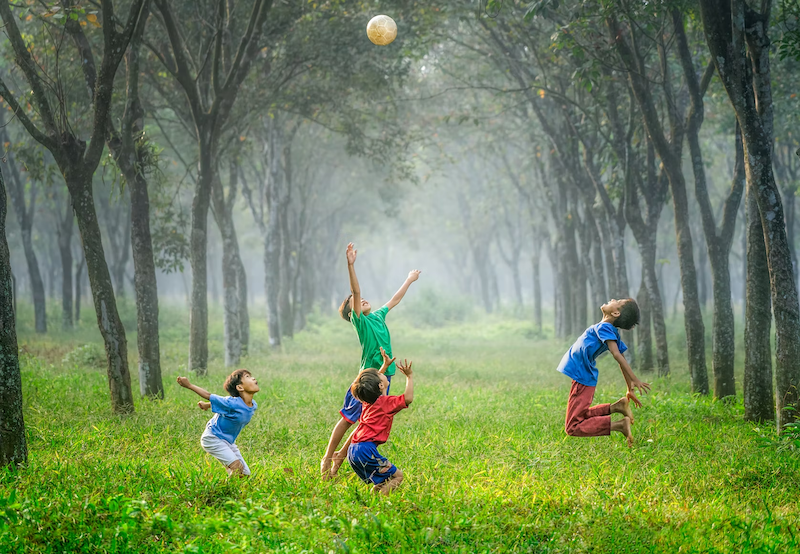
Image credit: Photo by Robert Collins on Unsplash (free license for use)
Charlotte Nickerson explains:
- People who live in individualist cultures tend to believe that independence, competition, and personal achievement are important. Individuals in Western nations such as the United States, England, and Australia score high on individualism (Oyserman, Coon, & Kemmelmier, 2002).
- People who live in collectivist cultures value social harmony, respectfulness, and group needs over individual needs. Individuals who live in countries in Asia, Africa, and South America score high on collectivism (Hofstede, 2001; Triandis, 1995).
The implications of this are numerous, but it is particularly important to note the values of the culture you identify with will influence your personality and dictate your accepted social norms and perception of appropriate social behavior. Having an awareness of cultural differences will enable you to be prepared for others to act in different ways you might expect, and you can be prepared to be tolerant of their differences. The CIS philosophy of respect for others and the IB Learner Profile attribute of caring are two key attributes that will help you to do this and ultimately enable you to build friendships and trust with others even though they may hold differing views.
As we approach the last week of our school year, let’s all consider our role in the CIS community, and regardless of if we come from a collectivist or individualist background, let us focus on student learning as our shared purpose, so as to enable us to work together within a respectful, supportive environment.
Upcoming events of note
- June 9: Last Day of School – Class celebrations, Moving Up Ceremonies, and End Year Assembly (half-day of school); Reports published
- 7:30 am ES/ 7:45 MHS: HR
- 8:30 am: G5 Moving Up Ceremony (virtual*)
- 9:00 am: G10 Moving Up Ceremony (virtual*)
- 10:00 am: Class Celebrations
- 10:45 am: EOY Whole School Assembly (virtual*) [Time subject to confirmation]
- 11:30am ES/ 11:45am MHS: Classes dismissed for summer vacation
*The link to these events will be distributed for parents optional viewing via email prior to the event
*For health and safety reasons, please note any snacks for the class celebrations must be brought from home for individual use/no sharing
- June 13-24: Summer Activities Program
Please refer to the CIS Event Calendar (http://cis.edu.ph/school-calendar/) for the complete calendar of school events.
Grade 2 Poets
by Ms. Maureen Juanson & Ms. Marina Ocleasa, Grade 2 HR Teachers
What is an inspiration? What inspires you? These are some of the questions that provoked the thinking of our Grade 2 students at the beginning of our unit, How We Express Ourselves. As we further inquired into self-expression, the Grade 2s realized that inspiration moves us to create something. These creations can range from written pieces, spoken words, performances, sounds, music, arts and crafts, and stories.
 As creative communicators, the Grade 2s learned to express themselves through poetry. Throughout the unit, the students immersed themselves in different types of poems, such as free verse, chant, acrostic, alliteration, and diamante. We spent some time reading like writers to notice how they are written and what writing techniques can be used in writing them. In the process, students also deepened their understanding and appreciation of language, like figures of speech, shades of meaning, and parts of speech.
As creative communicators, the Grade 2s learned to express themselves through poetry. Throughout the unit, the students immersed themselves in different types of poems, such as free verse, chant, acrostic, alliteration, and diamante. We spent some time reading like writers to notice how they are written and what writing techniques can be used in writing them. In the process, students also deepened their understanding and appreciation of language, like figures of speech, shades of meaning, and parts of speech.
We invite you to immerse yourselves in some creative poems written by our Grade 2 poets.
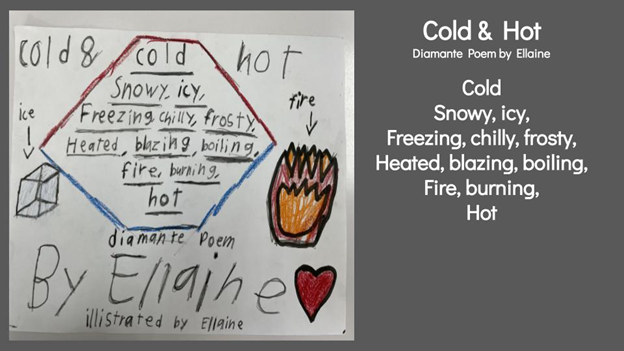

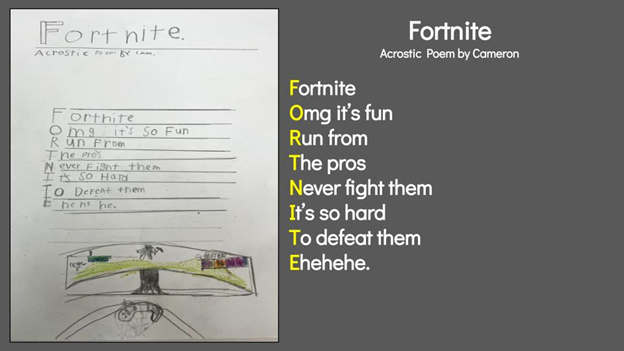
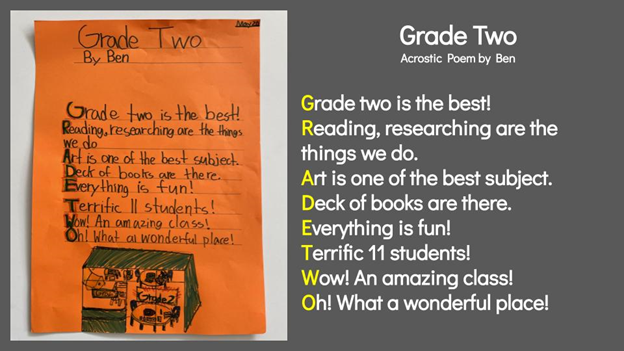


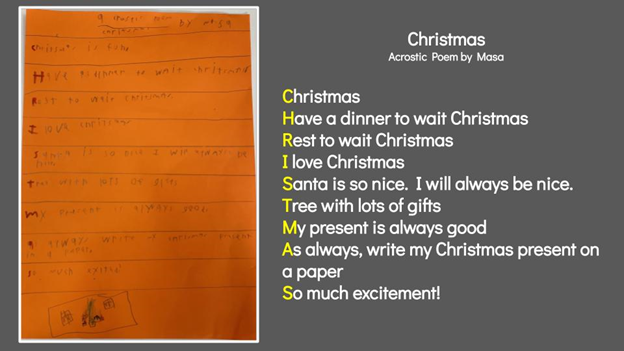
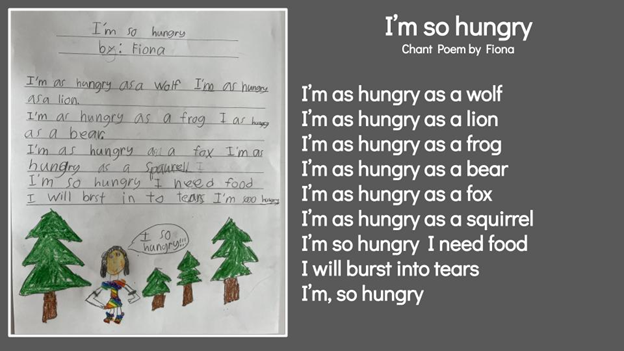
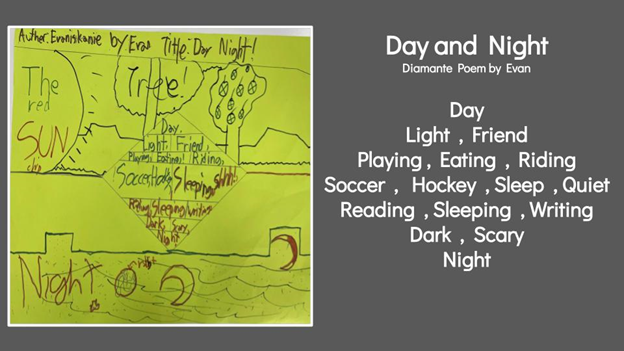

Science Class
by Ms. Haydee Montero, Science Teacher
Grade 6
How does electricity work?
Electricity is a form of energy resulting from the existence of charged particles such as electrons or protons. It is considered as a secondary source of energy, which means it is neither a renewable (solar, hydro, wind or geothermal source) nor a nonrenewable source (coal, fossil fuels, nuclear etc). It is called a secondary source because it is produced by converting 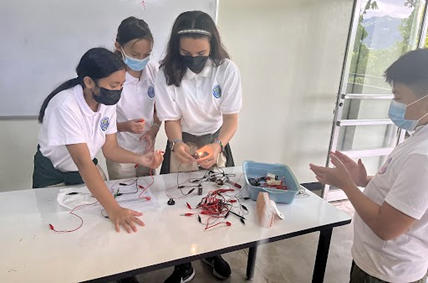 primary sources of energy from either renewable or nonrenewable sources.
primary sources of energy from either renewable or nonrenewable sources.
In the last exploration of Unit 4. “How does electricity work?” with the Statement of Inquiry: “Energy transformations lead to development in systems for an improved way of living”, the grade 6 students were so engrossed and were carefully probing on alligator wires, batteries (as source of power)and transistors/switches in order to light their bulbs.
 However, learning online is different from Rodd’s end. While using the PHET Simulation on CIRCUIT as an enhancement tool for the in-class students, the simulation App serves as the primary and ultimate tool in navigating electric circuitry for his online learning.
However, learning online is different from Rodd’s end. While using the PHET Simulation on CIRCUIT as an enhancement tool for the in-class students, the simulation App serves as the primary and ultimate tool in navigating electric circuitry for his online learning.
“Electricity works when electrons travel or flow from the battery down to electric wires all the way through the wires down to the bulb. The resistor and transistor/switch control the flow of the electricity and control the light of the bulb”-Rodd
Here are some snapshots of their actions caught on cam and their realizations on how electricity works:
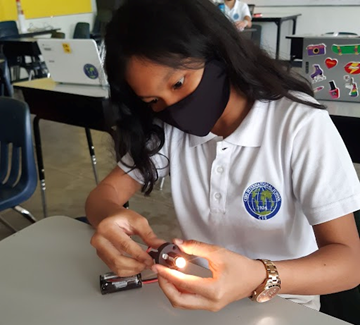
Arianna
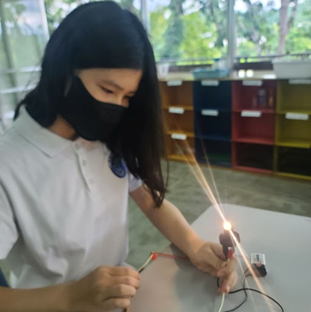
Jiwoo
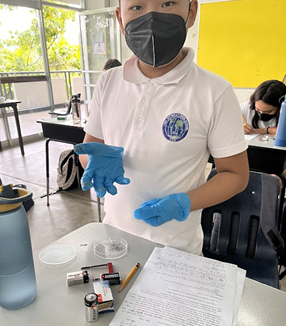
Kuto

Ghea
Whatever their realizations based on their explorations on electric circuitry, one thing is for sure, there is so much power in electricity.
“ Electricity can transform people’s lives, not just economically but also socially” –Piyush Goyal
Grade 7
The world is in constant motion, don’t get screwed!
Forces play a crucial role in our everyday lives. It can cause a moving object to: accelerate, decelerate, change direction, and even change shape. Forces enable people to create materials into something that is useful for them if not improve the quality of one’s living.
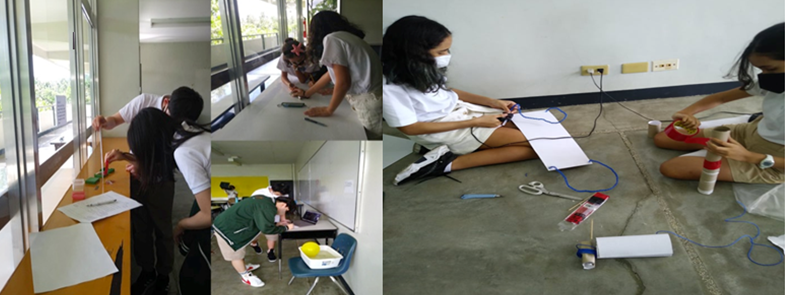
From navigating and measuring forces, the Grade 7 students ended up with their own contraption of an innovative machine, as an application of their understanding on how simple machines (lever, inclined plane, wheel & axle, pulley, wedge and screw) work.
Guided by the SOI “Understanding systems and how forms work enables us to design models to foster ingenuity and progress”, the students came up with their own innovation, a conglomerate of two or more simple machines.
Here are few examples of their works:
Ray-Ray, the industrious box is an innovative compound machine that saves time, energy and work more efficiently. To help you work more efficiently for example when you want to practice playing basketball so you can beat or impress your friends you might want to practice accuracy, well my product can help you with that! Someone you know might move Ray-Ray around while you stand behind a line far away. Because Ray-Ray is a bit small, it will help you improve your accuracy, according to (Nordland, 2019).- Chloe


This compound machine uses 2 different simple machines. This uses wheels and axles and an inclined plane. The wheels and axles are located at the bottom of the cart. The inclined plane is located inside the cart. The inclined plane uses gravity to make objects in the cart slide in 1 direction. The wheels on the bottom of the cart multiply force, using friction to push the cart in 2 directions (front and back) depending on where the cart is being pushed. The purpose of this cart is to help carry any heavy items which a user of this cart is struggling with. The inclined plane helps shift the force of the objects inside the cart into 1 specific direction. The wheels and axles of the cart help the user of the Supply Cart maneuver around with any objects in the cart with ease.-Niño
With so many challenges affecting the globe on a daily basis, I decided to use science and simple machines to assist solve one of those concerns in a more efficient and secure manner. The problem is that traveling alone at night or in a dangerous neighborhood can put you at risk from strangers. For instance, suppose you see or are being followed by an unknown individual and need to defend yourself. Willyam, the flashy defender, on the other hand, is here to save the day! as in literally. Willyam, the flashy defender, will guarantee that you have something to rely on in no time with the advantages of increasing force, lifting loads, and reducing human energy. By using science, this machine includes a wedge, inclined plane, screws, lever, and there you have it, a flashlight! The enemy is no match for Willyam, the flashy defender, and the defender will save time trying to save oneself by employing this product instead of their hands. Willyam will be there for you every step of the way in any “Stranger Danger” scenario. – M


My innovative machine is an upgrade of a ruler, not just because it’s longer than the original ruler, but because it is foldable to carry the machine more wisely. Originally it is 28 cm long, but if it’s unfolded it has a total length of 56cm which is 26cm longer than the original ruler. My innovative machine contains two simple machines: wedge & screw. The screw is used to attach the rulers and a wedge is attached for cutting like an exacto knife. The total length of the ruler can be advanced by attaching more and more rulers on it. (if it’s sold) This ruler will cost 350 php, made out of steel. – Andrew
These students may not be able to create the innovative machine just as they would have wanted it to be, but they were able to discuss and analyze the various implications of using Science and its application in solving a specific problem. THEY INNOVATE!
Paulo Coelho says, “Everybody has a creative potential from the moment you can express this creative potential, you can start changing the world”.
Grade 9
Ecosystem: Equilibrium is the key!
Keeping the ecosystem balanced is what everyone should consider at all costs. With an ecosystem set in an equilibrium state, sustainability is most likely achieved. The grade 9 students had been busy investigating the interplay between abiotic and biotic factors in the ecosystem to help maintain a homeostatic condition.
Each of them is working on specific scientific exploration that involves a common understanding on how an ecosystem operates guided by the SOI: Different systems within living organisms and ecosystems function and interact with each other.
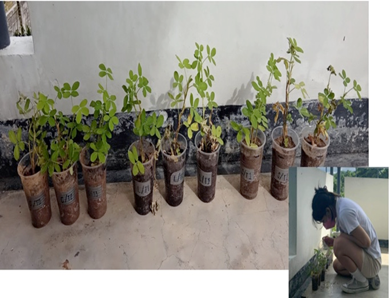
Gab is working on, “The Effect of the Type of Soil on The Arachis hypogea (peanut plant) Plant’s Growth.
The independent variable is the type of soil (sand, clay & loam) used. This is because this is the variable that has been intentionally changed to see if it affects the plant’s growth.
The dependent variable is the growth in plant (height of the plant) — how much the plant has grown and developed. This determines how well the type of soil has helped the plant to grow as fast as it can — to see and observe if the plant’s growth has been stunted or not.
Adam is working on, “An Investigation on the Rate of Decomposition on Malus sp.(apple)” .
The independent variable is the “cutting” or “non-cutting” of the apples. This is the one being manipulated in finding out which one will rot faster.
The dependent variable is the rotting of the fruit which is being observed and measured.
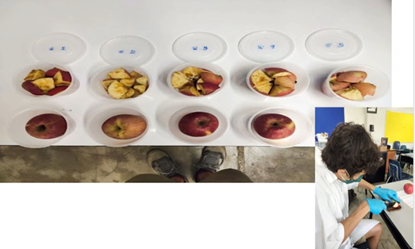

Elijah is working on, “The Effect of the Type of Seed ( Corn, Mongo, and Tomato Seeds) on the Speed of Germination”.
The independent variable is the types of seeds. This is because using 3 different types of seeds, and placing them in different Petri dishes to see which of the seeds will germinate faster, given the same conditions.
The dependent variable is the speed of germination because that is what we are trying to find out in this experiment.
Nika is working on “ The Investigation of Hand Sanitizers’ its effect on Controlling Bacteria “
The use of different brands of hand sanitizers is the independent variable because it is the factor that was manipulated and can change the results of the spittle.
The inhibition of bacterial growth is due to the results of the spittle reacting to the hand sanitizers being applied to it.

These explorations help provide a clearer perspective to these students coming from different cultures and beliefs regarding their role in the ecosystem. After all, “The environment is where we all meet; where we all have a mutual interest; it is the one thing all of us share.”-Lady Bird Johnson
Media Center/Library Reminders
by Ms. MJ, Media Center Staff

We are now in our few weeks before the school year ends. The Media Center would like to inform you that you may now return the books that you currently checked out before June 7, 2022. You may return the books to the main office with Ms. Kim or drop them in the Media Center. If you wish to keep the books over the summer, please send an email to Ms. MJ (mcordova@cis.edu.ph) and attach a photo of the books. You can also borrow books for the summer and send your requests in the second week of June. Please be informed that the turnaround time of the books that you’ll be checking out for the summer can be delayed due to COVID restrictions.
If you have any questions, please feel free to reach out to the Library/Media Center Staff, Ms. MJ (mcordova@cis.edu.ph ).
College/Careers Counselor Corner
by Ms. Jenny Basa, College/Careers Counselor Corner
CommonApp Essay Prompts 2022-2023
For Grade 11 students who are applying to universities via the CommonApp, here are the essay prompts for next school year. The essay should be at least 250 words and a maximum of 650 words in length.
- Some students have a background, identity, interest, or talent that is so meaningful they believe their application would be incomplete without it. If this sounds like you, then please share your story.
- The lessons we take from obstacles we encounter can be fundamental to later success. Recount a time when you faced a challenge, setback, or failure. How did it affect you, and what did you learn from the experience?
- Reflect on a time when you questioned or challenged a belief or idea. What prompted your thinking? What was the outcome?
- Reflect on something that someone has done for you that has made you happy or thankful in a surprising way. How has this gratitude affected or motivated you?
- Discuss an accomplishment, event, or realization that sparked a period of personal growth and a new understanding of yourself or others.
- Describe a topic, idea, or concept you find so engaging that it makes you lose track of time. Why does it captivate you? What or who do you turn to when you want to learn more?
- Share an essay on any topic of your choice. It can be one you’ve already written, one that responds to a different prompt, or one of your own design.
The essay is an opportunity for students to advocate for themselves and give the admissions committee a glimpse of their personality through their response to these prompts.
Upcoming Virtual Events and Fairs: (students & parents are welcome)
DATE
June 16
4:00 pm
Link to register
EVENT
Study Melbourne Info Session – Philippines:Hear from The University of Melbourne, Monash University, La Trobe University, Federation University and Swinburne University (TBC) and learn more about studying in Melbourne and Victoria.
June 18
12:00pm – 6:00pm
Link to register
Study Abroad Expo 2022 (Virtual Event)
Meet representatives from these institutions
- Australian Catholic University
- Bond University
- CQUniversity
- Curtin University
- Deakin University
- Federation University
- Flinders University
- Griffith University
- Kaplan Australia
- Kirana Colleges Australia
- Macquarie University
- The University of Queensland
- The University of Sydney
- The University of Western Australia
- University of New England
- University of the Sunshine Coast
- University of Wollongong
- UNSW Sydney
- Western Sydney University
June 14, 22 and 29
Taster Classes with Massey University (New Zealand)

SAT Update for 2022-2023
To register for the SAT, you may click on this link. If you need assistance or have any questions, please feel free to email Ms. Jenny Basa at jbasa@cis.edu.ph.
Below are the confirmed test dates for the paper/pencil SAT at Cebu International School.
| Scheduled Test Date | Status | Capacity |
| August 27, 2022 | Open | 60 |
| October 1, 2022 | Open | 60 |
| December 3, 2022 | Open | 60 |
Test dates after the 1st semester will be published as soon as available, these will be digital examinations.



